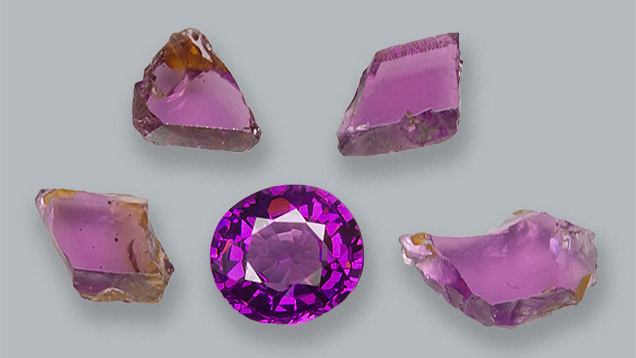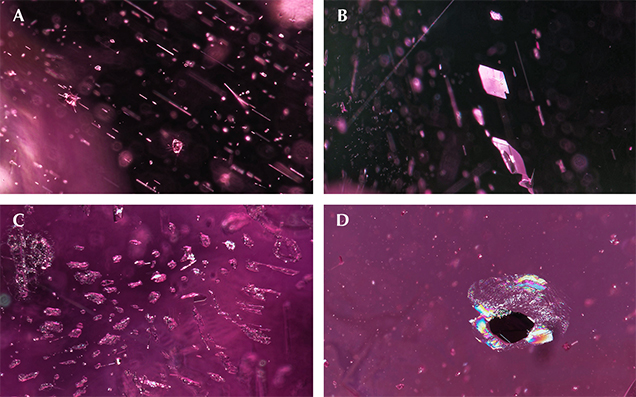Purple Pyrope-Almandine Garnet From Mozambique

In early 2016, attractive purple garnets from East Africa started to appear in the Bangkok market (T. Sripoonjan and T. Leelawatanasuk, “Preliminary investigation of purple garnet from a new deposit in Mozambique,” GIT Gemstone Update, 2016, pp. 1−6). Author VP purchased 17 samples (figure 1) at the Bangkok Gem Fair and inquired about their origin. Mark Saul of Swala Gem Traders (Arusha, Tanzania) informed him that the source was a very unstable area of Manica Province in central Mozambique. Ameen Ikram, a gem merchant from Sri Lanka, confirmed this after managing to visit the mining site in June 2016. The deposit is located about 60 km northeast of Chimoio, near Gorongosa National Park. The area is under the control of the Mozambican National Resistance (RENAMO), an armed rebel group.
The stones exhibited a vitreous luster. Standard gemological testing yielded an isotropic RI reading of 1.767 ± 0.003 and an SG value of 3.87 ± 0.02. An isotropic reaction with anomalous double refraction (ADR) was observed through the polariscope. The samples were inert when exposed to both long-wave and short-wave UV radiation. Examination with a gemological microscope revealed several internal features (figure 2), including individual and clustered zircon crystals, zircons with stress halos, black platelets of graphite, groups of colorless quartz crystals, thin films, needles, tubes, and iron stains in tubes. Raman spectroscopy was used to identify the mineral inclusions.

Advanced analytical techniques, including UV-Vis-NIR and Fourier-transform infrared (FTIR) spectroscopy and laser ablation−inductively coupled plasma−mass spectrometry (LA-ICP-MS), were used to collect additional information. The UV-Vis-NIR spectrum (figure 3, left) indicated electronic transitions of specific Fe and very weak Mn transition metal ions, as described in the literature (K. Krambrock et al., “Purplish-red almandine garnets with alexandrite-like effect: Causes of colors and color-enhancing treatments,” Physics and Chemistry of Minerals, Vol. 40, No. 7, 2013, pp. 555−562). All of the samples showed an iron spectrum including Fe2+ and Fe3+, and a weak absorption peak at 408 nm was assigned to Mn2+. The FTIR spectrum (figure 3, right) showed Fe2+ peaks at 4450 and 5820 cm−1 (R.G. Burns, Mineralogical Applications of Crystal Field Theory, Vol. 5, Cambridge University Press, Cambridge, UK, 1993, pp. 155−158), hydroxyl group features at around 3500−3600 cm−1 (G.R. Rossman et al., “Quantitative analysis of trace OH in garnet and pyroxenes,” American Mineralogist, Vol. 80, No. 5−6, 1995, pp. 465−474), and CO2 peaks at 2340−2360 cm−1. A minor FTIR peak at 2627 cm−1 might have resulted from the numerous inclusions in the samples. LA-ICP-MS analysis (table 1) revealed major amounts of Si, Al, Fe, and Mg, as well as minor amounts of Ca and Mn. Vanadium was also detected in very low concentrations, while titanium and chromium were below the detection limits. The LA-ICP-MS data confirmed the material’s identification as pyrope-almandine garnet with the following chemical components: 48.8−59.5% pyrope, 37.9−47.6% almandine, 2.0−3.5% grossular, and 0.5−0.6% spessartine.
| TABLE 1. LA-ICP-MS analyses of pyrope-almandine garnets from Mozambique. | |
| Oxide | Weight (%) ± SD (n = 5) |
| SiO2 | 42.34 ± 0.33 |
| Al2O3 | 25.41 ± 0.22 |
| FeO | 17.93 ± 1.31 |
| MgO | 13.16 ± 1.19 |
| CaO | 0.94 ± 0.20 |
| MnO | 0.22 ± 0.02 |
| V2O3 | 0.002 ± 0.001 |
| Cr2O3 | bdl |
| TiO2 | bdl |
|
n: number of studied samples
bdl: below detection limit SD: standard deviation |
|

The UV-Vis-NIR spectrum explains the purple color of the samples. Since the main absorption bands dominate the green-yellow regions of the visible spectrum, two strong blue and red transmission regions combine to produce an eye-visible purple color. These samples can be classified as pyrope-almandine garnet, commonly referred to as “rhodolite” garnet.



